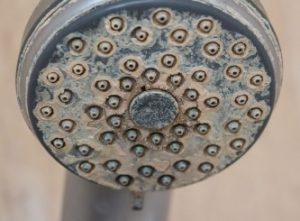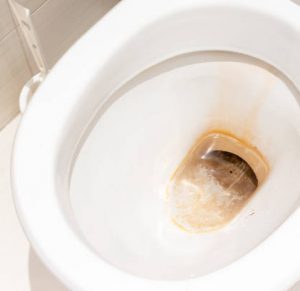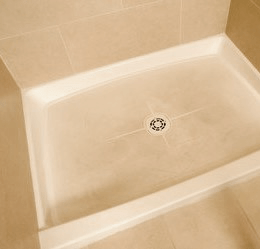What’s Causing Those Stains on Your Fixtures?
| White | Noticing foggy stains on clean dishes or shower doors? White scale on fixtures? Hard water is the culprit. | |
| Red/Orange | Rusty colored stains in your sinks and toilets generally mean iron in your water. | |
| Black/Brown | These dark brown stains indicate manganese and often occur with red-orange iron stains. | |
| Pink | Usually found in the bathroom, pink is usually not a stain but a dried bacteria. | |
| Green/Blue | Green and blue stains can be a sign of acidic or corrosive water that can damage pipes. |
Eliminate Frustrating, Embarrassing Iron and Rust Stains!
Are you tired of battling stubborn stains caused by iron or rust in your water? You’re not alone. Many homeowners face this common issue, but fret not! We’ve got you covered with effective solutions to reclaim the sparkle in your sinks and tubs.
 Iron is a naturally occurring mineral found in soil and water sources. When dissolved iron interacts with oxygen and moisture, it forms rust, leaving unsightly stains in your sinks and tubs. These stains often manifest as reddish-brown discoloration, resembling rust or mud residue. They not only tarnish the appearance of your fixtures but can also be a hassle to remove.
Iron is a naturally occurring mineral found in soil and water sources. When dissolved iron interacts with oxygen and moisture, it forms rust, leaving unsightly stains in your sinks and tubs. These stains often manifest as reddish-brown discoloration, resembling rust or mud residue. They not only tarnish the appearance of your fixtures but can also be a hassle to remove.
Potential Health Concerns with Iron in Your Tap Water
While iron in your water typically poses no direct health risk, it can affect the taste, odor, and appearance of your water. In some cases, high levels of iron may lead to a metallic taste or discoloration in beverages prepared with tap water. Additionally, excessive iron consumption over time may contribute to certain health issues, making it essential to address iron levels in your water.
Iron Bacteria: Understanding the Threat
In addition to causing unsightly stains, iron in your water can create favorable conditions for the growth of iron bacteria. Iron bacteria are microorganisms that thrive in environments with high iron levels, forming slimy, rust-colored deposits in pipes, fixtures, and water tanks.
While iron bacteria themselves are not harmful, their presence can lead to clogged plumbing systems, foul odors, and compromised water quality. Regular testing and proactive treatment are essential to prevent the proliferation of iron bacteria and maintain clean, healthy water.
Effective Cleaning Methods for Rust Stains
Fortunately, there are several methods to combat iron stains in the short term. For minor stains, a simple mixture of baking soda and vinegar can work wonders. Alternatively, specialized cleaners formulated to tackle stubborn rust stains are available in stores. For stubborn stains, consider using a professional cleaning service for expert assistance.
Why Test Your Water?
Testing your water is the first step towards understanding the extent of iron contamination and its potential impact on your household. A comprehensive water test provides valuable insights into the quality of your water, including levels of iron and other contaminants. Armed with this information, you can take proactive measures to address any issues and safeguard your family’s health.
The Solution: Rust Shield Peroxide Treatment System
Introducing Rust Shield, your comprehensive solution for tackling iron, manganese, and iron bacteria contamination. Our advanced peroxide treatment system not only efficiently oxidizes iron and manganese but also disrupts the growth and activity of iron bacteria, eliminating sulfur smells and safeguarding your water quality.
An iron filter orwater softenercan help reduce iron levels in your water. Regularly cleaning your fixtures and using specialized rust-removing cleaners can also help manage these stains.
Additional Causes of Water Staining
 | Hard water depositsOne of the most common culprits behind water staining is hard water. Hard water contains high concentrations of minerals, particularly calcium and magnesium. When hard water evaporates or dries on surfaces, it leaves behind mineral deposits that can build up over time. These deposits often show up as white, chalky stains on your fixtures. Solution: Installing awater softenercan effectively mitigate hard water staining. Softeners work by removing the minerals responsible for the stains, leaving your fixtures cleaner and free from mineral buildup. |
Bacterial growthSometimes, pink or orange stains in bathroom fixtures can be indicative of bacterial growth. These stains are often accompanied by a musty or earthy odor. Solution: Address the bacterial issue by regularly cleaning your fixtures with a disinfectant cleaner. Improving ventilation in your bathroom can also help prevent bacterial growth. | |
Acidic waterThese colors stem from slightly acidic or corrosive tap water. Low-pH water flowing through copper pipes can cause metals like copper and lead to leach into your home’s water. Solution: Our Corrosion Shield system can balance the pH of your water, eliminating the corrosive property. And it also enhances the taste of your water. | |
Manganese stainsDark brown or reddish-brown stains in your sinks and toilets are generally due to a high concentration of manganese and iron in your water. Left untreated, these stains will darken over time and are difficult to remove. Solution: A moderate level of iron and manganese can often be kept in check with a water softener, but a high concentration with require a system such as Rust Shield. | |
Mineral or soap scum build-upSoap scum and mineral deposits can accumulate on fixtures over time, especially in areas with hard water. These deposits can make fixtures appear dull and discolored. Solution: Regular cleaning with mild abrasives or vinegar-based solutions can help remove mineral and soap scum buildup. Preventive measures, such as using less soap or installing a water softener, can also help reduce the formation of these stains. | |
Leaking fixturesWater stains around your fixtures may be caused by leaks, which allow water to pool and cause discoloration. Leaks can also lead to mold and mildew growth. Solution: Cleaning and disinfecting affected areas can help prevent mold and mildew stains. However, if the root cause is a leak, the faulty fixture should be repaired or replaced promptly bylicensed plumber. |
The Right Solution Starts with an Accurate Test
The first step in eliminating unsightly water stains is to have your water professionally tested.
 | U.S. Water offers comprehensive well water testing services through its Wisconsin state-certified water testing lab. This ensures the most accurate testing and, with our test facility onsite, you are guaranteed a fast turnaround time. In addition to our basic analysis, we offer a full range of certified water tests and well inspection services. |

Eliminate the troublesome staining caused by iron in your well water with our exclusive Rust Shield system.

Rent our equipment hassle-free!
Our rental options cover all equipment, offering a trouble-free maintenance agreement plus consumables for your convenience.
Not sure which product you need?
TALK TO ONE OF OUR WATER CONSULTANTS





